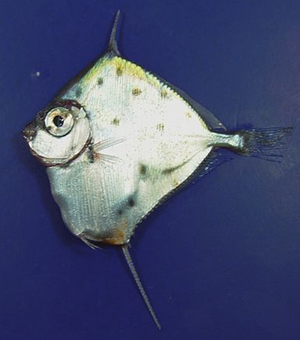Grammicolepidinae
| Grammicolepidinae | ||||||||||||
|---|---|---|---|---|---|---|---|---|---|---|---|---|

Xenolepidichthys dalgleishi |
||||||||||||
| Systematics | ||||||||||||
|
||||||||||||
| Scientific name | ||||||||||||
| Grammicolepidinae | ||||||||||||
| Poey , 1873 |
The Grammicolepidinae are a subfamily of the Grammicolepididae within the Petersfischischen and comprise two of three species of the family (all except Macrurocyttus acanthopodus ). They occur in the Atlantic , Indian and Pacific over the continental slopes at depths of 120 to 1000 meters.
features
The species of Grammicolepidinae are maximally 15 or 64 cm long and have a particularly high-backed, laterally flattened body, large eyes, a small mouth and two separate dorsal fins. The body is covered with vertically stretched scales. The upper jaw is shorter than the diameter of the eye. The number of Branchiostegal rays is 7, those of the vertebrae 37 to 44, of which 10 to 11 are in the abdomen and 8 to 10 in the caudal peduncle. Of the five hypuralia , the first four are fused with the vertebrae, the fifth is free. Two epuralia, elongated, free-standing bones in the caudal fin skeleton, can also be found. A basic phenoid (sphenoid bone) is present as a short shaft on the front of the posterior myodoma . Also parietal and Metapterygoid are available. One to numerous ribs are ossified. There are also numerous epineuralia (bones).
- Fins formula : dorsal V – VII / 27–34, anal II / 27–35, ventral I / 6, caudal 15 (one additional tributary ray each above and below).
The edges of various pelvic rays are serrated. In juvenile fish, the first fin spine of the anal fin is greatly elongated.
Systematics
There are two types in two monotypical genera :
-
Grammicolepis
- Grammicolepis brachiusculus Poey , 1873 .
-
Xenolepidichthys
- Xenolepidichthys dalgleishi Gilchrist, 1922 .
literature
- James C. Tyler, Bruce O'Toole & Richard Winterbottom: Phylogeny of the Genera and Families of Zeiform Fishes, with Comments on Their Relationships with Tetraodontiforms and Caproids. Smithsonian Contributions to Zoology • Number 618
- Joseph S. Nelson : Fishes of the World , John Wiley & Sons, 2006, ISBN 0-471-25031-7
Web links
- Grammicolepidinae on Fishbase.org (English)